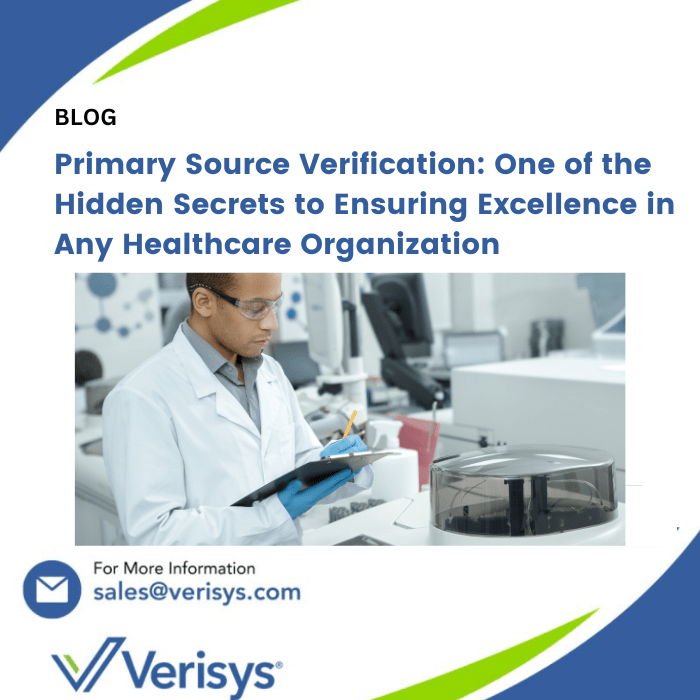– The best resource for monthly healthcare regulatory compliance updates. Compliance Updates: April 2024 Overlook: Licensure Compacts Other Legislation Board Updates Interstate Medical...


Primary Source Verification: One of the Hidden Secrets to Ensuring Excellence in Any Healthcare Organization. Did you know that August is National Primary Source Verification Month?
Dedicating an entire month to primary source verification may seem unusual. But, it is crucial to raise awareness of this essential task in the healthcare setting that helps keep patients safe.
Let’s take this opportunity to review the importance of primary source verification during the healthcare credentialing process.
Healthcare credentialing is the tedious process of assessing a healthcare provider’s qualifications, experiences, and competency. This process ensures the applicant meets your organization’s requirements for employment and involves verifying the following:
To complete the credentialing process, one must use primary sources to confirm the accuracy of the data submitted on the application.
Medical staff service teams typically check at least half a dozen primary sources to properly verify a healthcare provider’s credentials. Examples of primary source institutions that verify credentials and how include the following:
It often takes 90 days or more to onboard and grant privileges to healthcare providers. Bottlenecks can pop up every step along the way, prolonging the process. However, primary source verification (PSV) should not be rushed. Missing critical information in the credentialing process can significantly affect your organization.
Here are four reasons why a thorough PSV process is essential:
Compliance with regulatory standards from CMS or other regulatory-setting bodies should be non-negotiable. However, in an attempt to quickly credential a practitioner to help relieve shortages or backlogs of patients needing to be seen, shortcuts may be taken.
A thorough PSV process ensures your healthcare organization complies with state and federal regulations. This helps guarantee that all practitioners in your organization meet the requisite licensing and certification requirements.
By adhering to these standards, healthcare institutions demonstrate their commitment to delivering high-quality and ethical care.
A strong reputation is paramount to the success of any healthcare organization. All it takes is one negligent credentialing lawsuit to ruin a hard-earned reputation.
Using PSV strengthens your credibility and shows your dedication to excellence and patient safety. This commitment, in turn, will attract patients to your institution.
Malpractice claims and legal disputes can financially and emotionally drain healthcare providers and organizations. A thorough PSV process helps mitigate these risks by ensuring all practitioners have the necessary qualifications and licenses to perform the duties they are being hired to perform.
Proactively screening applicants and continuously monitoring them helps to minimize the likelihood of hiring individuals with a questionable background, thereby reducing potential liabilities and future legal challenges.
The well-being of patients receiving care within your organization should be at the forefront of patient safety. PSV helps safeguard patients from being treated by an incompetent or underqualified healthcare provider.
Healthcare credentialing doesn’t only apply to physicians. Any healthcare provider, vendor, or contract employee providing indirect or direct patient care must be thoroughly vetted before entering your organization.
By confirming the authenticity of a practitioner’s or vendors credentials, healthcare organizations can take the first step in reducing the risk of medical errors due to subpar care. This also helps to foster an environment of trust and confidence in the services provided.
The best way to perform PSV will depend on the size of your organization and the resources available to you. Some have automated processes, while others manually check individual primary sources. Regardless, it is essential to have policies and procedures in place for how your organization will handle the credentialing and re-credentialing process. It is best to never deviate from those policies.
Some organizations choose to partner with a credentials verification organization (CVO). This cuts back on administrative hours dedicated to PSV, saving time and money in the long run. Regulatory-setting bodies consider the information a CVO provides the organization an appropriate method for verifying a provider’s credentials.
Not all CVOs are created the same or accredited or certified by nationally recognized organizations. It is important to note that even if you use a CVO, you still need in-house policies and procedures detailing the credentialing process. Your organization is also responsible for reviewing documentation from the CVO and making a credentialing decision.
Here at Verisys, we make credentialing easy. We are a fully certified and accredited CVO. Our credentialing solutions are backed by the most comprehensive primary source database – FACIS®.
If you are considering partnering with a CVO or want to learn more about our credentialing solutions, schedule an appointment to speak with one of our representatives today.